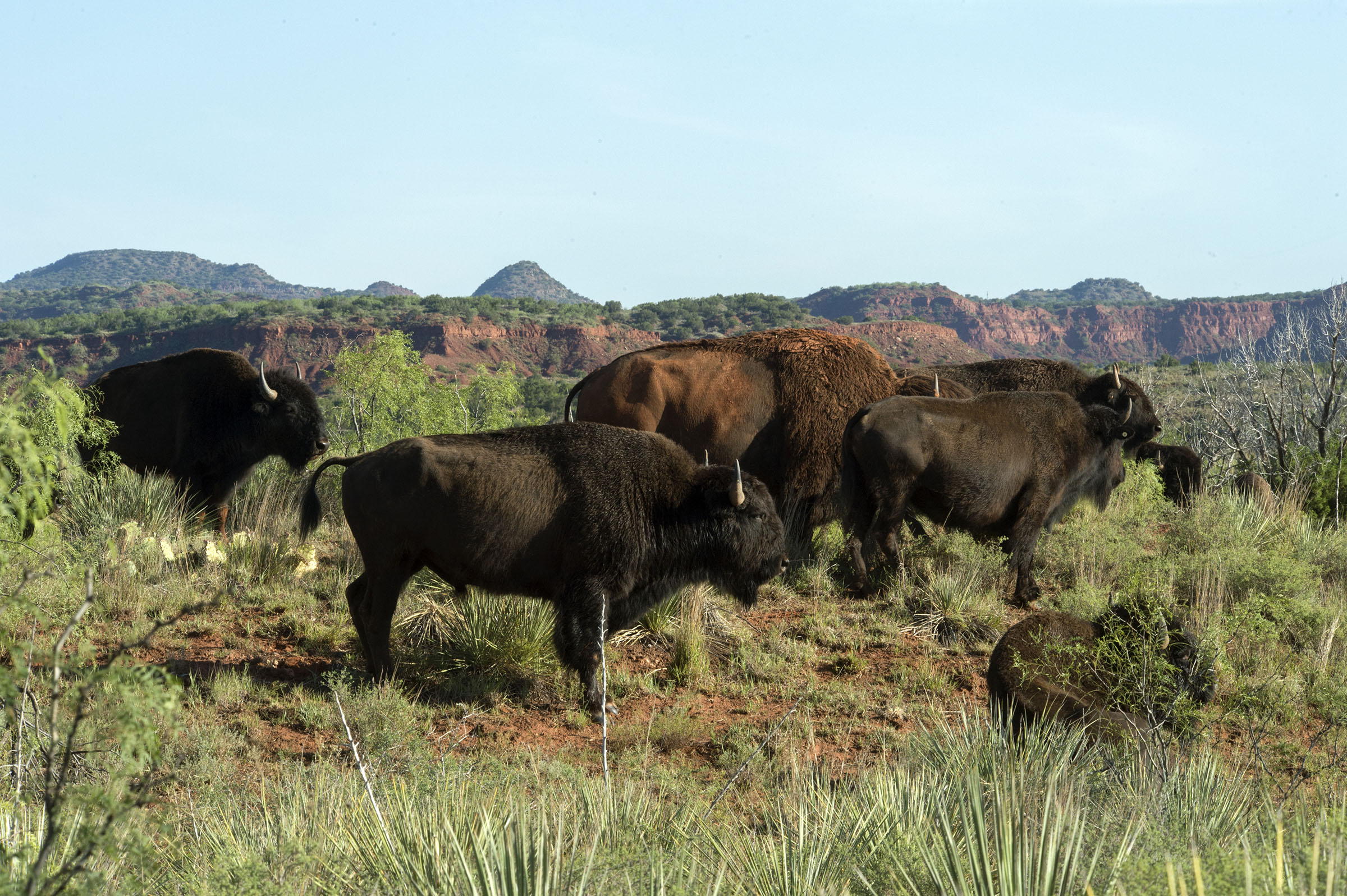
Bison at Caprock Canyons State Park. Photo by Kevin B. Stillman
The Texas State Parks system marks its 100th anniversary this year. With 89 parks, natural areas, and historic sites to choose from, visitors can experience all kinds of outdoor activities. Each month, we’re highlighting activities based on the season and special occasions around the state.
Clarity Tunnel Bat Tours
Address: Meet at Monk’s Crossing, Mile Marker 284.5 Ranch Road 689. Guests drive to the South Plains trailhead to board the van. Maps are available at park headquarters located at 850 State Park Road.
Hours: Approximately 6:45 p.m. (depending on sunset); every Friday, June-August
Admission: $10 for tour. Park admission is $5 for adults, free for children 12 and under. Registration and fees are due at the time of registration, and there is a 24-hour cancellation policy.
Phone: 806-455-1492
Website: tpwd.texas.gov
When you drive into Caprock Canyons State Park and Trailway, don’t be alarmed if you find yourself face-to-face with a bison. The park has a free-roaming herd of the shaggy beasts that occasionally create traffic jams on the road.
In August, things get particularly wild all over this park, located about 50 miles northeast of Plainview in the Texas Panhandle. That’s because offspring born to its wild occupants have grown big enough to start roaming the park’s 14,000 acres, along with the Trailway’s 1,200 acres. Baby prairie dogs and bison calves charm visitors in the main park, while thousands of Mexican free-tailed bat pups start to fly from their home in Clarity Tunnel along the Trailway.
Bison, probably the first critters you’ll see coming into the park, are the largest land animal in North America, with males tipping the scales at up to 2,000 pounds. That’s one ton, the same as a small car. Females weigh less than 900 pounds, and calves are a mere 50 pounds at birth. By now, though, they’re plenty big to easily spot.
These animals are part of the Texas State Bison Herd and some of the last known Southern Plains Bison. All are descendants of a handful of orphaned wild calves rescued by Mary Ann and Charles Goodnight of the JA Ranch in 1878. They grew those animals into a herd of more than 200. The herd faded into obscurity and only 50 or so remained when wildlife conservationist Wolfgang Frey spearheaded an effort to donate the animals to the state of Texas in 1996. The herd moved to Caprock Canyons in 1997.
“Our capacity is 200 to 250 bison and right now we have about 246 based on aerial surveys,” says park superintendent Donald Beard.
An essential part of prairie ecosystems, bison increase the variety of plants and animals through their grazing. Their wallowing behavior creates mini-wetlands, and their waste fertilizes prairie plants.
At the park, the furry beasts turn just about anything into a scratching post, Beard says. The park even installed one of its standard wooden park signs labeled as an official bison scratching post (look for it on the road to park headquarters).
If you’re lucky enough to encounter them, keep this in mind: Because they are so big, bison need a lot of personal space, Beard stresses—at least 50 yards (half a football field) as a rule. Keep a safe distance and, if your presence is causing the bison to change their behavior, leave the area. The animals have the right-of-way on park roads; never honk at, push, or tailgate bison. (Remember, they may weigh more than your car!)
Less prone to roam are the prairie dogs, and the best place to see them is by the Honey Flat campground, according to park employee Le’Ann Pigg. Offspring pop out of burrows along with their parents. These native black-tailed prairie dogs live in complex “towns” of underground tunnels and are most active during the cool hours of the day, socializing and feeding on grass and herbs (or Cheetos, as they do in Lubbock). One sentry keeps watch, barking out a warning at any sign of danger that sends all the other members of the community diving back into their burrows. Pigg says the town near Honey Flat is pretty used to humans and so not quite as skittish as might be typical (but visitors should remain at a respectful distance, of course). Female prairie dogs have one litter of four to five pups, which venture outside starting at about six weeks of age. “Cute” only begins to describe them.
Lodging
There are 30 campsites with electricity, nine with water, and three primitive walk-in campgrounds with a total of 56 spots at Caprock Canyons State Park. Another lodging option is rustic Lake Theo Lodge. Operated by the park, it has two bedrooms, a large living area, and full kitchen. Primitive camping is allowed anywhere on the Trailway with a permit (obtained at park headquarters). There are limited services, and campers must bring their own water.
Like the prairie dogs, bats are not large but still easy to see if you are in the right place at the right time. That place is Clarity Tunnel and the time is summer at sunset. The tunnel was part of the Fort Worth and Denver South Plains Railway built by Burlington Northern in 1928 to provide freight and passenger service between Lubbock and Estelline. Clarity Tunnel was added to the National Register of Historic Places in 1977 and the Texas Parks and Wildlife Department acquired 64 miles of the rail line in 1992 with the help of the Rails-to-Trails Conservancy.
Now, Clarity is home to about half a million Mexican free-tailed bats from late March until late September. Some of the residents are males, but many are females raising pups. They give birth in June and the pups start to fly in August. These bats consume thousands of pounds of insects each night, many of them agricultural pests.
The tunnel is 4.5 miles from the Monk’s Crossing trailhead and 13 miles from the South Plains trailhead. The park offers guided van tours to see bat emergences on Fridays in June, July, and August, depending on staff availability. Tours, which last about two hours, are guided and provide information on the history of the trail and tunnel and wildlife in the area. Advance registration is required by calling the park (see sidebar for more information).
“You’ll see spectacular views of the Llano Estacado, and we get there early so you can see the tunnel itself, which is about 540 feet long,” Pigg says, adding that people also can hike, bike, or horseback ride to the tunnel. She recommends wearing bandanas and walking horses and bikes to avoid stirring up the guano. Avoid disturbing the bats, and flash photography is not allowed.
The main park has an additional nearly 90 miles of hiking, biking, and equestrian trails ranging in distance from 1 to 15 miles and varying in difficulty from easy to quite steep and rugged, but with incredible views as a reward.








